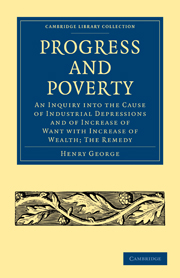 Progress and Poverty
Progress and Poverty Book contents
- Frontmatter
- PREFACE TO FOURTH EDITION
- Contents
- INTRODUCTORY
- BOOK I WAGES AND CAPITAL
- Chapter I The current doctrine—its insufficiency
- Chapter II The meaning of the terms
- Chapter III Wages not drawn from capital, but produced by the labor
- Chapter IV The maintenance of laborers not drawn from capital
- Chapter V The real functions of capital
- BOOK II POPULATION AND SUBSISTENCE
- BOOK III THE LAWS OF DISTRIBUTION
- BOOK IV EFFECT OF MATERIAL PROGRESS UPON THE DISTRIBUTION OF WEALTH
- BOOK V THE PROBLEM SOLVED
- BOOK VI THE REMEDY
- BOOK VII JUSTICE OF THE REMEDY
- BOOK VIII APPLICATION OF THE REMEDY
- BOOK IX EFFECTS OF THE REMEDY
- BOOK X THE LAW OF HUMAN PROGRESS
- CONCLUSION
- INDEX
Chapter V - The real functions of capital
Published online by Cambridge University Press: 07 September 2011
- Frontmatter
- PREFACE TO FOURTH EDITION
- Contents
- INTRODUCTORY
- BOOK I WAGES AND CAPITAL
- Chapter I The current doctrine—its insufficiency
- Chapter II The meaning of the terms
- Chapter III Wages not drawn from capital, but produced by the labor
- Chapter IV The maintenance of laborers not drawn from capital
- Chapter V The real functions of capital
- BOOK II POPULATION AND SUBSISTENCE
- BOOK III THE LAWS OF DISTRIBUTION
- BOOK IV EFFECT OF MATERIAL PROGRESS UPON THE DISTRIBUTION OF WEALTH
- BOOK V THE PROBLEM SOLVED
- BOOK VI THE REMEDY
- BOOK VII JUSTICE OF THE REMEDY
- BOOK VIII APPLICATION OF THE REMEDY
- BOOK IX EFFECTS OF THE REMEDY
- BOOK X THE LAW OF HUMAN PROGRESS
- CONCLUSION
- INDEX
Summary
It may now be asked, If capital is not required for the payment of wages or the support of labor during production, what, then, are its functions?
The previous examination has made the answer clear. Capital, as we have seen, consists of wealth used for the procurement of more wealth, as distinguished from wealth used for the direct satisfaction of desire; or, as I think it may be defined, of wealth in the course of exchange.
Capital, therefore, increases the power of labor to produce wealth: (1) By enabling labor to apply itself in more effective ways, as by digging up clams with a spade instead of the hand, or moving a vessel by shoveling coal into a furnace, instead of tugging at an oar. (2) By enabling labor to avail itself of the reproductive forces of nature, as to obtain corn by sowing it, or animals by breeding them. (3) By permitting the division of labor, and thus, on the one hand, increasing the efficiency of the human factor of wealth, by the utilization of special capabilities, the acquisition of skill, and the reduction of waste; and, on the other, calling in the powers of the natural factor at their highest, by taking advantage of the diversities of soil, climate and situation, so as to obtain each particular species of wealth Where nature is most favorable to its production.
- Type
- Chapter
- Information
- Progress and PovertyAn Inquiry into the Cause of Industrial Depressions and of Increase of Want with Increase of Wealth; The Remedy, pp. 71 - 78Publisher: Cambridge University PressPrint publication year: 2009First published in: 1881
